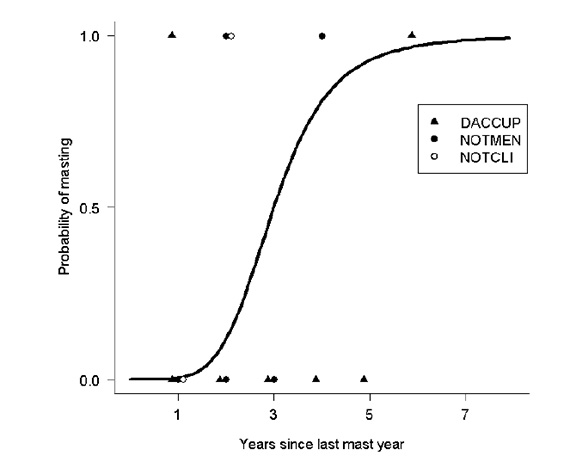
Ecological Archives M085-008-A5
David M. Forsyth, Deborah J. Wilson, Tomás A. Easdale, Georges Kuntsler, Charles D. Canham, Wendy A. Ruscoe, Elaine F. Wright, Lora Murphy, Andrew M. Gormley, Aurora Gaxiola, and David A. Coomes. 2015. Century-scale effects of invasive deer and rodents on the dynamics of forests growing on soils of contrasting fertility. Ecological Monographs 85:156–179. http://dx.doi.org/10.1890/14-0389.1
Appendix E. Modeled probability of mast seeding in Dacrydium cupressinum and Nothofagus spp.
Figure E1 shows the function (solid line) used to calculate whether mast seeding occurs for any of three masting tree species, in each time-step of the SORTIE/NZ model. The probability of masting is modeled as an increasing function of years since the previous mast year. Observed data for these species are also shown (points).
Fig. E1. Modeled probability of mast seeding (solid line) in Dacrydium cupressinum (DACCUP), Nothofagus menziesii (NOTMEN) and N. solandri var. cliffortioides (NOTCLI). Points show observed above-average (plotted as 1 on vertical axis) and below-average (0 on vertical axis) seedfall events for these species in Waitutu Forest as a function of number of years since the previous above-average event (2002–2009; Canham et al. 2014). With this function, the mean probability of a mast year was 0.29 (SD = 0.45), equating to masting occurring on average every 3.43 years. The masting function was applied independently to the two genera because they mast asynchronously (Schauber et al. 2002). Plant names follow http://nzflora.landcareresearch.co.nz/ (accessed 4 October 2012).
Literature cited
Canham, C. D., W. A. Ruscoe, E. F. Wright, and D. J. Wilson. 2014. Spatial and temporal variation in tree seed production and dispersal in a New Zealand temperate rainforest. Ecosphere 5(4):49.
Schauber, E. M., et al. 2002. Masting by 18 New Zealand plant species: the role of temperature as a synchronizing cue. Ecology 83:1214–1225.